-
Open mySewnet™ Cross Stitcher
 and in the Start Page of the Cross Stitch Design Wizard select Load Picture for New Cross Stitch Design, then click Next. In the Choose Picture page, click Load a Picture
and in the Start Page of the Cross Stitch Design Wizard select Load Picture for New Cross Stitch Design, then click Next. In the Choose Picture page, click Load a Picture  and load Documents\mySewnet\Samples\Cross Stitch\Pics\Small House.jpg., then click Next twice. In the Design Size page ensure the Cross Size is set to 2.0mm, and the Width and Height are set to 40 crosses. Then click Finish to display the house in the design area.
and load Documents\mySewnet\Samples\Cross Stitch\Pics\Small House.jpg., then click Next twice. In the Design Size page ensure the Cross Size is set to 2.0mm, and the Width and Height are set to 40 crosses. Then click Finish to display the house in the design area. -
In the Home tab, click Design Properties and in the Design Properties dialog box ensure that Thread Count, Crosses and Backstitch are set to Single (2 Threads). Click OK.
-
On the View tab, ensure the Grid Size is set to Every 5 lines
 .
. -
Click the Create tab.
-
In the Shape section, ensure that No Fill
 is selected (the icon to the left in the Fill area).
is selected (the icon to the left in the Fill area). -
Click to select the Backstitch Outline
 option (the middle icon in the Outline area).
option (the middle icon in the Outline area).
-
Click the thread color for Outline, and in the pop-up palette click Add Color
 . The Color Selection dialog box appears.
. The Color Selection dialog box appears. -
In the Thread Range drop-down list, select Sulky Rayon 40.
Choose from any of the manufacturer’s thread ranges or one of the MyThreads ranges you created using mySewnet™ Thread Cache. -
Enter 1005 in the Find Thread box, and the list will highlight Sulky Rayon 40 1005 (Black). Click OK.
-
In the Shape drop-down menu, ensure that Rectangle (shape 1) is selected.
-
Click Place Shape
 . A rectangular shape is placed in the center of the design area.
. A rectangular shape is placed in the center of the design area. -
Click and drag the corners of the shape to make a rectangle which fits just inside the outline of the front of the house. The rectangle should be 24 grid squares wide by 11 high.
-
Right-click to place the shape.
-
In the Fill section, select Cross Fill
 .
. -
Click the thread color for Fill, and in the pop-up palette click Add Color
 . The Color Selection dialog box appears.
. The Color Selection dialog box appears. -
Enter 1246 in the Find Thread box, and the list will highlight Sulky Rayon 40 1246 (Orange Flame). Click OK.
-
Click Place Shape
 . A rectangular shape is placed in the center of the design area.
. A rectangular shape is placed in the center of the design area. -
Click and drag the corners of the shape so that it forms a rectangle six grid squares wide by nine grid squares high to create a door for the house.
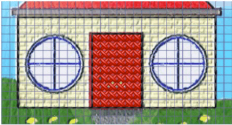
-
Right-click to place the shape.
-
At the left of the ribbon bar, click the thread color for Crosses, and in the pop-up palette select the black color.
This is Sulky Rayon 40 1005 (Black) that you selected earlier. -
Click Full Cross
 .
. -
Draw a roof gutter across the top of the wall, one grid square deep and one grid square wider than the wall on each side of the house.
-
Click the Standard Backstitch icon
 . This draws backstitch lines on the sides and diagonals of grid squares.
. This draws backstitch lines on the sides and diagonals of grid squares. -
Now draw the roof. At the left hand end of the roof gutter, click and drag from one square in from the end (1), to place a line of five diagonal sections of standard backstitch up and to the right, then release the mouse button or lift the pen (2).

If you prefer, you can place each section of standard backstitch with a single click. Right-click is set to Erase, so you can use single right-clicks to erase individual sections of standard backstitch. -
At the right hand end of the roof gutter, click and drag from one square in from the end (3), to place a line of five diagonal sections of standard backstitch up and to the left (4).
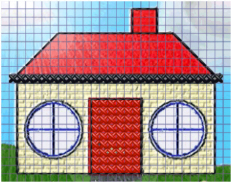
-
Click and drag along the grid line to place a line of backstitch along the top of the roof (2 to 4).
-
Now draw the chimney. At the top right of the roof, start two grid squares in from the end. Click and drag to place a line three squares straight up, then a second line three squares left, then a third line three grid squares back down to the roof.
-
In the Shape section of the Create tab, click No Fill
 .
. -
Ensure that Backstitch Outline
 is selected.
is selected. -
Click the Smooth option so it is checked.
Use Smooth to smooth the outline around shapes. -
In the Shape drop-down menu, select the Circle (shape 2).
-
Click Place Shape
 . A circle is placed in the center of the design area.
. A circle is placed in the center of the design area. -
Drag the circle over the left window of the house, then hold down the Ctrl key and move the handles on the box so they lie along the grid lines framing the window.
Holding the Ctrl key while dragging resizes the shape proportionally. -
Click Zoom To Rectangle
 and the arrow pointer changes to the zoom in pointer
and the arrow pointer changes to the zoom in pointer  .
. -
Click and drag around the left half of the house, then release the mouse button or lift the pen to zoom in.
-
Check the positioning of the circle, then right-click to place the shape.
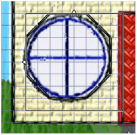
If the window does not match the picture, click Undo and try again. -
Look at the Design Panel. The Color Select area contains threads that are currently available for use in a design.
Colors can be added individually and then used, or added automatically when designs, shapes or lettering are inserted using thread colors that are not already in the palette. When the pointer is positioned over a color in this area, a tooltip shows the full thread color name. -
At the left of the ribbon bar, click the thread color for Crosses, and in the pop-up palette click Add Color
 . The Color Selection dialog box appears.
. The Color Selection dialog box appears. -
Ensure the thread range is set to Sulky Rayon 40, and enter 1030 in the Find Thread box. The list will jump to Sulky Rayon 40 1030 (Periwinkle). Click OK. The color is added to the Color Select area and set as the drawing color in the ribbon bar.
-
Click the Cross Flood Fill icon
 and the pointer changes to the paint bucket
and the pointer changes to the paint bucket  .
. -
Click inside the window and it will fill with pale blue crosses.
-
At the left of the ribbon bar click the thread color for Crosses, and in the pop-up palette select the black color.
This is Sulky Rayon 40 1005 (Black) that you selected earlier. -
Click the Freehand Backstitch icon
 .
. -
Click and drag a line across the middle of the window, then another line down the middle of the window.
-
Click the Home tab.
-
Click Box Select
 .
.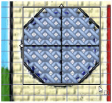
-
Click and drag a square around the window.
-
Click the Copy icon
 .
. -
Click Zoom To Fit
 .
. -
Click Paste
 . A new copy of the window will appear at the top left of the screen.
. A new copy of the window will appear at the top left of the screen. -
Click and drag the window to the right-hand side of the house in a similar position to the window on the left.
-
Click the Create tab.
-
At the left of the ribbon bar, click the thread color for Crosses, and in the pop-up palette click Add Color
 . The Color Selection dialog box appears.
. The Color Selection dialog box appears. -
Enter 1066 in the Find Thread box, Sulky Rayon 40 1066 Primrose is selected. Click OK.
-
Click the Cross Flood Fill icon
 and the pointer changes to the paint bucket
and the pointer changes to the paint bucket  .
. -
Click the front wall of the house.
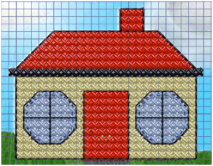
-
At the left of the ribbon bar, click the thread color for Crosses, and in the pop-up palette select the red color.
This is Sulky Rayon 40 1246 (Orange Flame) that you selected earlier. -
Click on the main part of the roof and the chimney.
Notice that you can change the fill color while you still have the Cross Flood Fill tool active.
If the whole picture fills with crosses, click Undo and check the backstitch outline of the roof for gaps. -
Click the thread color for Crosses, and in the pop-up palette select the black color (Sulky Rayon 40 1005 Black).
Click the Full Cross icon .
. -
Click and drag under the door to place a row of six black crosses as a doorstep. (Alternatively, click six times to place individual crosses.)
-
Click the French Knot icon
 .
. -
Click one square in from the left edge of the door and four squares up to place a door handle.
-
In the Shape section, select Cross Fill
 and select No Outline
and select No Outline  .
. -
Click the thread color for Fill, and in the pop-up palette click Add Color
 . The Color Selection dialog box appears.
. The Color Selection dialog box appears. -
Enter 1011 in the Find Thread box, and the list highlights Sulky Rayon 40 1011 (Steel Gray). Click OK.
-
In the Shape drop-down menu, select the Rectangle (shape 1).
-
Click Place Shape
 . A rectangular shape is placed in the center of the design area.
. A rectangular shape is placed in the center of the design area. -
Click and drag the corners of the shape so that the rectangle is placed under the doorstep, making a short path that is six crosses wide and three crosses high. Right-click to deselect.
-
Click the thread color for Fill, and in the pop-up palette click Add Color
 .
. -
In the Color Selection dialog box, enter 1100 in the Find Thread box to select Lt. Grass Green from Sulky Rayon 40. Click OK.
-
Place a rectangle of crosses that is 11 wide by four high on the left of the doorstep and path. It should be two squares wider than the house.
-
Click Zoom To Rectangle
 and the arrow pointer changes to the zoom in pointer
and the arrow pointer changes to the zoom in pointer  .
. -
Click and drag around the grass rectangle.
-
At the left of the ribbon bar click the thread color for Crosses, and in the pop-up palette click Add Color
 .
. -
In the Color Selection dialog box, select Sulky Rayon 40 1187 (Mimosa Yellow). Click OK.
-
Click the French Knot icon
 .
. -
Start two squares in and two squares down from the top left of the grass, and click in the center of the grid square to place the first yellow flower head. Move right and place four more flower heads in the center of alternate grid squares.
-
Click the thread color for Crosses, and in the pop-up palette click Add Color
 .
. -
In the Color Selection dialog box, Select Sulky Rayon 40 569 (Garden Green). Click OK.
-
Click the Freehand Backstitch icon
 .
.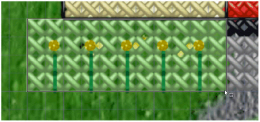
-
Start from the center of a grid square containing a yellow flower head and click and drag to draw a backstitch line two grid squares straight down. This is the stem for the flower. Repeat this for the other four flowers.
-
Click the Home tab.
-
Click Box Select
 .
. -
Click and drag a selection box around the grass and flowers.
-
Click Copy
 .
. -
Click Zoom To Fit
 .
. -
Click Paste
 and the grass rectangle with flowers will appear in the top-left corner.
and the grass rectangle with flowers will appear in the top-left corner. -
Click and drag the pasted grass to the right-hand side of the path.
See Load a Picture of a House for a detailed description of this process.
The Outline thread is now black.
This is from about 10 squares in and 15 squares down from the top left of the design area, at the top left of the front of the house.
A red Cross Fill ![]() and black Backstitch Outline
and black Backstitch Outline ![]() are now selected, and the Shape is set to rectangle.
are now selected, and the Shape is set to rectangle.
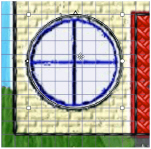
Use Freehand Backstitch to add backstitch lines of any length to a design. Freehand Backstitch snaps to half-grid spacing. By contrast, Standard Backstitch only places fixed length lines that snap to the sides and diagonals of grid squares.
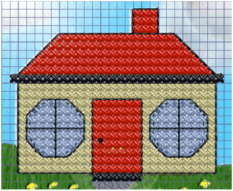
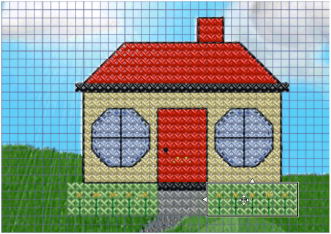
Use File, Save As to save the design as Small House.krz, and use Export ![]() to export the design as Small HouseExported.vp4.
to export the design as Small HouseExported.vp4.
Draw and Fill a Cross Stitch Border
-
Close mySewnet™ Cross Stitcher

if it is open, and in mySewnet™ Configure

click the Appearance tab.
-
For Background, click the drop-down arrow and then click More Colors on the drop-down panel. The Colors dialog box appears, with the Standard tab selected.
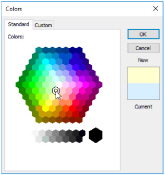
-
In the hexagonal matrix, click the pale yellow hexagon that is just down and to the left of the central white hexagon, then click OK. The new color is shown on the Background button.
-
Set the texture to Aida, then click OK.
-
Open mySewnet™ Cross Stitcher

. The Cross Stitch Design Wizard opens at the Design Options page.
-
In the Design Options page select Start a New Cross Stitch Design with no Picture.
-
Click Next, and the Design Size page appears.
-
Set the Cross Size to 1.5mm, and click Select Hoop.
-
In the Hoop Selection dialog box select the Universal Hoop Group, then set Hoop Size to 240mm x 150mm - Universal Large Hoop 2. Ensure the Orientation is Rotated, and click OK. The design area will be calculated and the preview area will show the grid size for the chosen hoop with the selected cross size.
-
Click Finish.
-
On the Home tab, click the Design Properties button.
-
In the Design Properties dialog box ensure that in Thread Count both Crosses and Backstitch are set to Single (2 Threads). Click OK.
-
On the View tab, ensure that the grid is set to Every 5 Lines

.
-
Click the Create tab on the ribbon bar.
-
In the Shape area, click the Backstitch Outline

option, and ensure that No Fill

is selected.
-
Click the thread color for Outline, and in the pop-up palette click Add Color

. The Color Selection dialog box appears.
-
Ensure that Robison -Anton Rayon 40 is selected as the Thread Range.
-
Enter 2289 in the Find Thread box, and the list will highlight Robison-Anton Rayon 40 2289 (Rust). Click OK.
-
In the Shape drop-down menu, ensure that the square (shape 1) is selected.
-
Click Place Shape

. A square is placed in the center of the design area.
-
Click and drag the corner handles on the square to create a rectangle one square inside each edge of the design area.
-
Right-click to place the rectangle.
-
Click Place Shape

to place a second square, then click and drag to create a second rectangle that is four squares inside the first rectangle. Right-click to place.
-
Click the Pattern tab in the ribbon bar, and in Category select Blackwork Basic.
-
In the pattern gallery, select the Lattice 1 pattern. When it is selected, a sample of the pattern and its color are shown to the right of the list.
-
Click the black thread color for the pattern and the Color Selection dialog box appears. Enter 2289 in the Find Thread box, and the list will highlight Robison-Anton Rayon 40 2289 (Rust). Click OK and the pattern preview will also show the new color.
-
Click the Create tab.
-
Click the Pattern Flood Fill icon

and the pointer changes to the paint bucket

. Click in the space between the two rectangles. The border is filled with a cross stitch pattern.

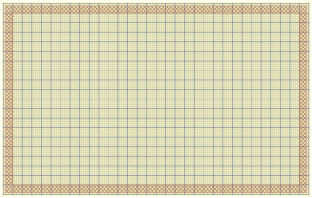
To add a title to this sampler, see Create Title Text for a Sampler.
After completing this exercise, you can use the Appearance tab of mySewnet™ Configure
to set the Background Color back to the default blue (RGB 211, 233, 255), and to change the texture to Woven.
Draw Filled Shapes for a Sampler
-
In the Appearance tab of mySewnet™ Configure

, set the Background to RGB 255, 255, 204, and set the Texture to Aida.
-
Open mySewnet™ Cross Stitcher

. The Cross Stitch Design Wizard opens at the Design Options page.
-
In the Design Options page select Load Existing Cross Stitch Design, and then click Next.
-
In the Open Existing Design page, click Load a Design

and browse to Documents\mySewnet\Samples\Cross Stitch\Krz\MySamplerText.krz. Click Finish to close the wizard.
-
Click the Multiply tab on the ribbon bar.
-
Click Use Multiply

. Blue reflection line(s) appear in the design area.
-
Ensure that Reflect Across

is selected.
-
Click Zoom To Rectangle

and the arrow pointer changes to the zoom in pointer

.
-
Click and drag around the central area of the design to zoom in.
-
Click the Create tab on the ribbon bar.
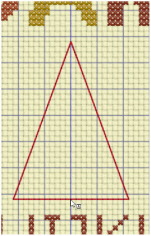
-
Select Freehand Backstitch

.
-
At the left of the ribbon bar, click the thread color for Crosses, and in the pop-up palette click color 7, Robison-Anton Rayon 40 2263 Foxy Red, then click outside the palette to close it.
-
Place the pointer on the central vertical grid line, three grid squares below the A.
-
Click and drag down and to the right, until the pointer is three squares above the top right part of the ’K’, then release the mouse button.
-
From there, click and drag to draw a horizontal line to the central vertical grid line to form a triangle.
Ensure the triangle is split by the center grid line, so that it is in the center of the design. If not, use Undo and try again. -
Click the Multiply tab on the ribbon bar.
-
Click Use Multiply

so that it is no longer selected. The blue reflection lines are no longer shown.
-
Click the Home tab on the ribbon bar.
-
Click Box Select

, then click and drag to select the triangle.
-
Click the Multiply tab on the ribbon bar.
-
Click Use Multiply

. The blue reflection line appears again.
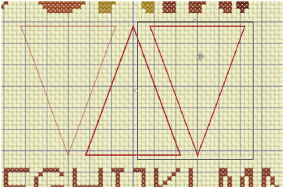
You cannot select an area while Multiply is enabled. -
Click the Home tab on the ribbon bar.
-
Click Duplicate

. A copy is placed below and to the right of the original, with a shadow copy to its left.
-
Move the pointer over the Flip Vertical handle on the copied block and it becomes the vertical double-arrow pointer. Click the Flip Vertical handle

to mirror the block vertically.
-
Move the copy so that it is level with the original triangle, and four squares to the right of it.
-
Right-click outside the block to place both triangles.
-
If needed, click and drag the horizontal scroll bar at the bottom of the work area to the right, so that you can see the empty space to the right of the new triangle.
-
Click the Create tab on the ribbon bar.
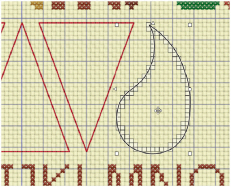
-
In the Shape area, for Fill select Cross Fill

, and for Outline select No Outline

.
-
In the Shape drop-down menu select shape 42, a teardrop.
-
Click Place Shape

to place the shape in the design area.
-
Click and drag the shape into the space to the right.
-
Hold down Ctrl, and click and drag a corner handle to resize the shape proportionally until it is the same height as the triangle.
-
Move the teardrop so that the tip of the teardrop is three grid squares to the right of the top right tip of the triangle.
-
Right-click to place the shape.
-
Click Cross Outline

.
-
Click the Outline color for Shapes, and in the pop-up palette click Add Color

.
-
In the Color Selection dialog, ensure that Robison-Anton Rayon 40 is selected as the Thread Range.
-
In the Find Thread box enter 2461 (Robison-Anton Rayon 40 2461 Wheat), then click OK.
-
In the Shape pop-up menu select 27, a star.
-
Click Place Shape

to place the shape in the design area.
-
Click and drag the shape into the empty space to the right of the teardrop.
-
Hold down Ctrl and click and drag a handle to resize the star proportionally until it is the same height as the teardrop, and place it between the teardrop and the sampler frame.
-
Right-click to place the shape.
-
Click Zoom To Fit

. You can now see all the shapes on the left that were duplicated by the Multiply feature.
-
Click the Multiply tab on the ribbon bar.
-
Click Use Multiply

so that it is no longer selected. The blue reflection lines are no longer shown.
-
Click the Pattern tab.
-
In the Pattern area, scroll down to select the Chevron 1 pattern from the Blackwork Basic Category.
-
In Thread Colors, click the color for the pattern. In the Color Selection dialog box, enter 2263 in the Find Thread box (Robison-Anton Rayon 40 2263 Foxy Red), then click OK.
-
Click the Create tab on the ribbon bar.
-
Click the Pattern Flood Fill icon

then click inside the center triangle.
-
Click the Pattern tab on the ribbon bar.
-
Scroll up to select the Brick 1 pattern from the Blackwork Basic Category.
-
Click the color for the pattern. In the Color Selection dialog box, enter 2263 in the Find Thread box (Robison-Anton Rayon 40 2263 Foxy Red), then click OK.
-
Click inside the triangle on the right.
-
Select the Stripes 3 pattern from the Cross Basic Category.
-
Click the first color for the pattern. In the Color Selection dialog box, enter 2289 in the Find Thread box (Robison-Anton Rayon 40 2289 Rust), then click OK.
-
Click the second color for the pattern. In the Color Selection dialog box, enter 2332 in the Find Thread box (Robison-Anton Rayon 40 2332 Penny), then click OK.
-
Click in the teardrop shape on the right to fill it with the stripes.
-
Select the Check 4 pattern from the Cross Basic Category.
-
Click the second color for the pattern. In the Color Selection dialog box, enter 2289 in the Find Thread box (Robison-Anton Rayon 40 2289 Rust), then click OK.
-
Click in the teardrop shape on the left to fill it with the check pattern.
-
Select the Diagonal 4 pattern from the Cross Basic Category.
-
Click the first color for the pattern. In the Color Selection dialog box, enter 2461 in the Find Thread box (Robison-Anton Rayon 40 2461 Wheat), then click OK.
-
Click the second color for the pattern. In the Color Selection dialog box, enter 2580 in the Find Thread box (Robison-Anton Rayon 40 2580 Green Grass), then click OK.
-
Click in the star on the left to fill it with diagonal stripes.
-
Select the Weave 3 pattern from the Mixed Category.
-
Click the first color for the pattern. In the Color Selection dialog box, enter 2461 in the Find Thread box (Robison-Anton Rayon 40 2461 Wheat), then click OK.
-
Click the second color for the pattern. In the Color Selection dialog box, enter 2580 in the Find Thread box (Robison-Anton Rayon 40 2580 Green Grass), then click OK.
-
Click in the star on the right to fill it with the weave pattern.
Alternatively, use the design you created in Add Letters and Numbers to a Sampler.
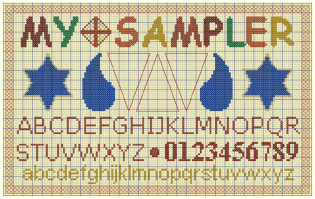
If desired, turn off the grid to see the effect of the brick pattern, then turn the grid on again to continue.
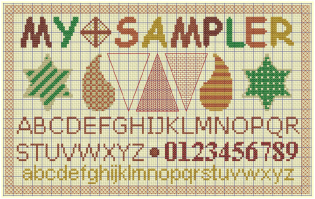
To create a new fill pattern for the final triangle, see Create a Fill for a Triangle in a Sampler.
After completing this exercise, you can use the Appearance tab of mySewnet™ Configure
to set the Background Color back to the default blue (RGB 211, 233, 255), and to change the texture to Woven.